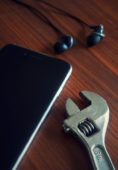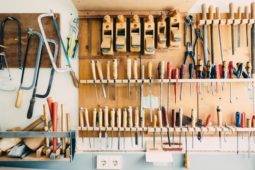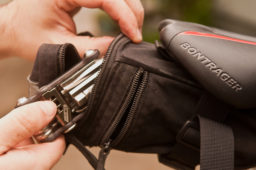Manmade Essential Toolbox: Why You Should Definitely Own a Really, Really Good Circular Saw
Each week in 2015, ManMade is sharing our picks for the essential tools we think every creative guy and DIYer needs. We’ve selected useful, long-lasting tools to help you accomplish a variety of projects, solve problems, and live a hands-on lifestyle that allows you to interact with and make the things you use every day.

A circular saw is one of those essential toolbox items I’m guessing a lot of you already have. It’s often the first powered saw for many DIYers. But do you have a really good one that you love and trust using? And if not, why should you care?
For years my circular saw was something that had been handed down to me in a dusty milk crate by a friend’s dad. Yours may have been picked up for next-to-nothing at a garage sale, or even found on the side of the road, or bought cause it was the cheapest option at the home center. Hey – no judgement here. Some of those old tools are awesome and solid. But a circular saw is powerful, versatile and potentially dangerous, so using one of poor quality, or in poor condition, is bad practice, and can actually lead to serious injuries.
Why Do I Need One?
The circular saw is one of the most versatile, portable cutting power tool there is. It can make cross cuts (across the wood grain), rip cuts (with the grain), and plunge cuts (where the blade starts out above the material and is lowered into it). Circular saws (almost) always have a bevel adjustment, which lets you cut your material on an angle. And they’re more portable than a miter saw or table saw (imaging trying to get one of those onto a roof).
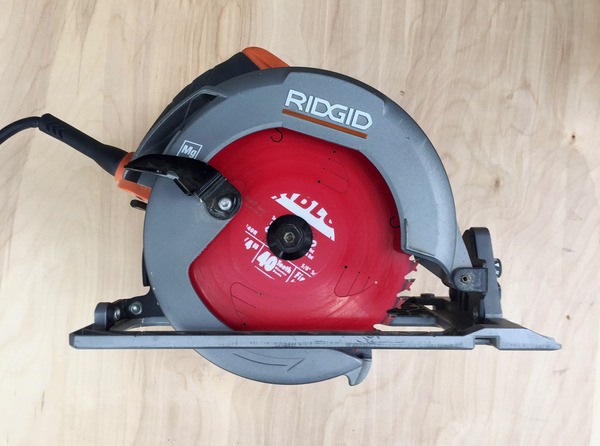
The portability of circular saw also allows you to make some cuts that just aren’t possible/safe on other tools (for example, ripping a piece of plywood or cutting down a door). You take the tool to the work, and not the other way around.
Why else do you need one? Well, they’re relatively cheap compared to table or miter saws. You can get a very nice one for $75-$150 . For the new homeowner or occasional tree-house-for-my-kids builder, I’d recommend it as the first power cutting tool you should own.
But! Circular saws are also dangerous! More so than miter saws, table saws, or jig saws. Less scary than chainsaws, I guess, but you know … chain saws are mostly for killing people anyway. Circular saws have a nasty tendency to kick back, and especially in the hands of unexperienced or incautious woodworkers, can cause accidents.

In order to minimize kickback, you should:
- Set the proper blade depth. Use the adjustment lever to set the saw’s base so that the blade extends about 1/4 – 1/2″ below the board. The ideal position is 1/8″ above the deepest gullet (the little valley between teeth). Be sure to tighten the base before making your cut.
- Support the wood wisely. Place your cut line just to the outside of your support (table, bench, saw horses), with the waste to the outside. If you can avoid it, don’t support both sides of a cross cut; this prevents the wood from binding and pinching the blade. Use clamps on the non-waste side whenever possible to keep the wood from moving.
- Make sure the saw blade is spinning at full speed before it enters the wood. This is true for all power tools, but the blade (or bit) need to be at either 100% or 0% when they either enter OR exit the wood. Half speed is where things get scary.
What Should You Look For in a Circular Saw?
I’ll give you my product picks below, but here are the things I look for in a good circular saw that will be pleasant to use and last forever.
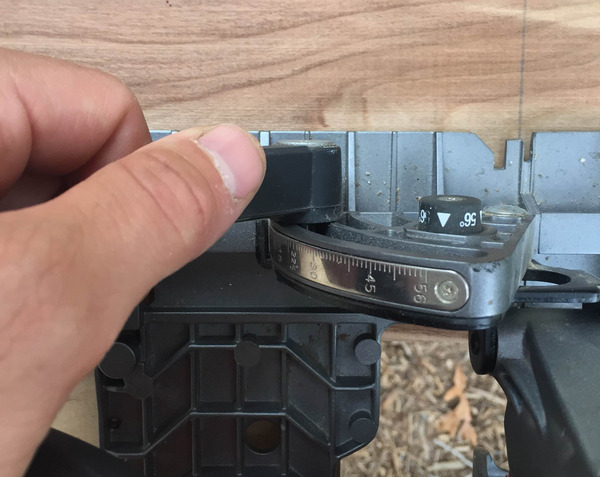
- Power. A cheap, underpowered saw will spin slower, causing the blade to dull and heat up, which make it more prone to catching in the wood and … you guess it … kicking back at your face arms, or crotch.
- Balance, weight and fit. It’s a hand-held power tool, folks, you want it to be comfortable to use. Not too heavy (unless you’re trying to bulk up your forearms), easy to grip, and well-balanced.
- Easy to adjust. The blade depth and bevel angle should be easy to change, and stay completely locked in place. I like saws that have large lever lock adjustment mechanisms, rather than those with screw-knobs for adjustment
- Durable. Super crazy durable. Circular saws get a lot of use. They get thrown around, dropped, stepped on … you get the picture. You want one with a reinforced cast aluminum or magnesium shoe and thick rigid plastic casing. The cord and electrical plug should be rugged.
- Accuracy of bevel adjustment. No point making cuts that aren’t true. Quality saws have nice long levers that are able to lock without a lot of force. This allows you to dial in precision angles, and keep them there until you decide to change it. The best saws will easily reset to 90°, without having to check a reference square.
- Cut line visibility. Yeah … you kind of want to be able to see where you’re cutting. This will be a little different for every person (left- or right-handed, etc.), but check the baseplate for easy to read notches and marks. LED lights don’t hurt, either. (Lasers are overrated).
One More Thing
Don’t use the stock blade that comes with your saw. They’re not just not very good, and manufacturers don’t intend them for real work. You need to learn how to choose the right blade for your material (recommendations on that below, but it’s probably this one).
Which One Should I Buy?
If you’re not planning on doing any serious framing, construction, or roof-raising any time soon, I think you’d be very happy with the $99 Ridgid 3200 15-Amp 7.25-inch Circular Saw. It’s the one I have, and I like it a lot.
If you plan on heavier use, the Makita 5007MG ($150) is a more expensive option that includes a work light, large, comfortable adjustment levers, and larger-than-usual cutting capacity.
Hey! Those are both sidewinder saws, you say! What about wormdrives?! Yeah, man, wormdrives are cool, super powerful, and tend to have better cut line visibility. Contractors, in particular, seem to prefer them. They take a little more practice to use (just because of the more extreme torque they can produce), and are a little heavier than their sindwindy cousins. The $214 SKIL SHD77M seems to get reviewers’ nods, but the one I’ve used (and liked a lot) was the Ridgid R3210 ($169).

ManMade Recommended:
Sidewinder
- For most people: Ridgid 3200 ($99)
- For pros (or pros-to-be): Makita 5007MG ($150)
Worm Drive
- Less money: Ridgid R3210 ($169)
- More money: SKIL SHD77M ($214)
Cordless?
Sure, but only if you already have a good corded saw. The Milwaukee 2630 ($117) is the one I’d get.
Blades
- For 90% of cuts in solid wood, plywood, or MDF, we recommend the Irwin Marathon 24T blade. Start there, then get your specialty blades as needed. It’s 16.80 well spent.



